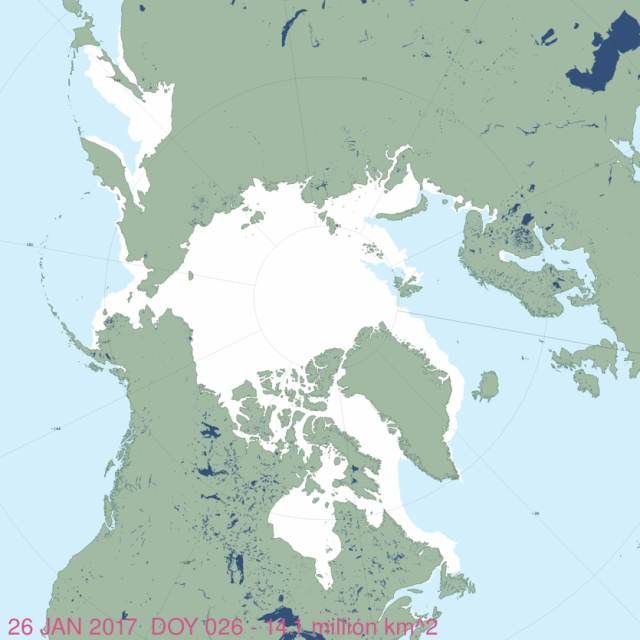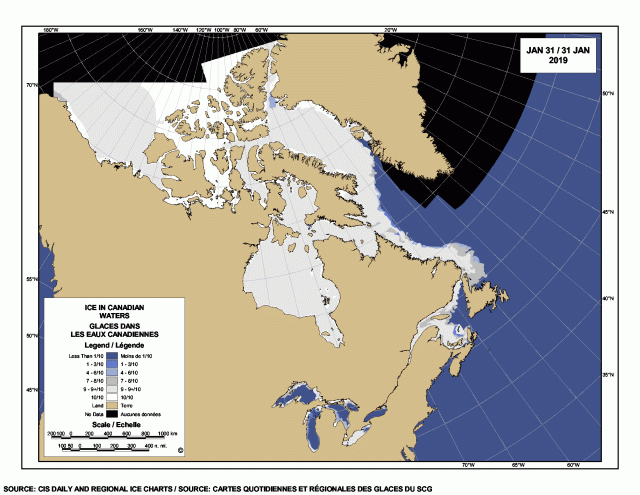Abundant polar bear habitat across the Arctic at the start of winter
Abundant polar bear habitat across the Arctic at the start of winter

Here is what the sea ice looked like around the Arctic at the end of this month.

Compare to last year:

And the year before that (2017):

A closer look at conditions in Canada and Alaska:

Compared to last year:

And the year before that (2017), where there was much less ice in the Gulf of St. Lawrence:

In contrast, there has recently been lots of ice compared to conditions in eastern Canada at 31 Jan 2010:

Further east, north of Norway, Barents Sea ice has expanded remarkably over the last few months:

Here is what polar bear specialist Andrew Derocher had to say about the state of the ice in the Barents Sea:
Svalbard sea ice 4th lowest area on record for Jan 31. At 273,936 sq km, it’s 128,447 sq km lower than the 1981-2010 average. Circled area outlines den areas that pregnant females didn’t have access to in the autumn due to lack of sea ice. It’s unknown where they may have gone. pic.twitter.com/79o8Ew548h
— Andrew Derocher (@AEDerocher) February 1, 2019
Derocher is continuing to pretend that the small area of southeastern Svalbard where he once did some field work is critical denning habitat for Barents Sea bears and to pretend he doesn’t know where alternative sites are available. He sang the same song last year about this time. I’ve fixed his sea ice chart for him, see below.

I know he knows that Franz Josef Land is a denning refugium because he co-authored one of the papers that points out the known alternative denning areas in Franz Josef Land and the Barents Sea pack ice around it (Andersen et al. 2012, see also Aars 2015; Aars 2018; Aars et al. 2017; Andersen and Aars 2016; Wiig 1998).

Polar bear specialist Jon Aars found three times as many polar bears in the Russian portion of the Barents Sea as around Svalbard in 2004 (Aars et al. 2009), which means that denning in Svalbard is much less important to the entire population than Derocher implies. Recent evidence that shows Svalbard bears are thrivingdespite much less ice than existed in the 1980s (Aars 2018) make Derocher and his message of doom look foolish and unprofessional.
References
Aars, J. 2015. Research on polar bears at Norwegian Polar Institute. Online seminar (‘webinar”), January 14. pdf here.
Aars, J. 2018. Population changes in polar bears: protected, but quickly losing habitat. Fram Forum Newsletter 2018. Fram Centre, Tromso. Download pdf here (32 mb).
Aars, J., Marques,T.A, Lone, K., Anderson, M., Wiig, Ø., Fløystad, I.M.B., Hagen, S.B. and Buckland, S.T. 2017. The number and distribution of polar bears in the western Barents Sea. Polar Research 36:1. 1374125. doi:10.1080/17518369.2017.1374125
Aars, J., Marques, T.A., Buckland, S.T., Andersen, M., Belikov, S., Boltunov, A., et al. 2009. Estimating the Barents Sea polar bear subpopulation. Marine Mammal Science 25: 35-52.
Andersen, M. & Aars, J. 2016. Barents Sea polar bears (Ursus maritimus): population biology and anthropegenic threats. Polar Research 35: 26029.
Andersen, M., Derocher, A.E., Wiig, Ø. and Aars, J. 2012. Polar bear (Ursus maritimus) maternity den distribution in Svalbard, Norway. Polar Biology 35:499-508.
Wiig Ø. 1998. Survival and reproductive rates for the polar bears at Svalbard. Ursus 10:25–32.


